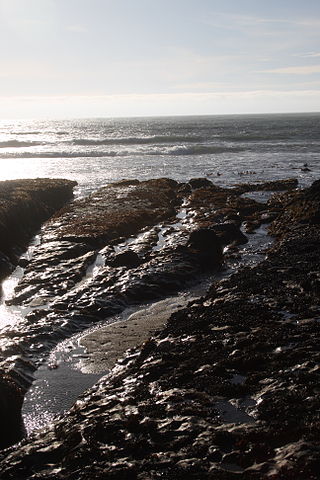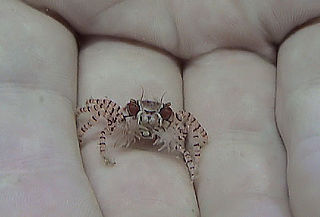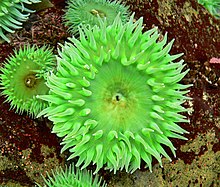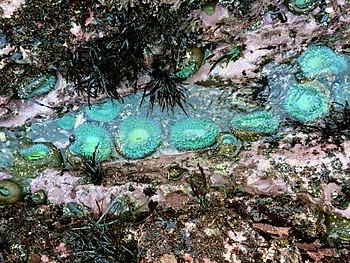
Anthozoa is a class of marine invertebrates which includes the sea anemones, stony corals and soft corals. Adult anthozoans are almost all attached to the seabed, while their larvae can disperse as part of the plankton. The basic unit of the adult is the polyp; this consists of a cylindrical column topped by a disc with a central mouth surrounded by tentacles. Sea anemones are mostly solitary, but the majority of corals are colonial, being formed by the budding of new polyps from an original, founding individual. Colonies are strengthened by calcium carbonate and other materials and take various massive, plate-like, bushy or leafy forms.

A tide pool or rock pool is a shallow pool of seawater that forms on the rocky intertidal shore. These pools typically range from a few inches to a few feet deep and a few feet across. Many of these pools exist as separate bodies of water only at low tide, as seawater gets trapped when the tide recedes. Tides are caused by the gravitational pull of the sun and moon. A tidal cycle is usually about 25 hours and consists of one or two high tides and two low tides.

Heteractis magnifica, also known by the common names magnificent sea anemone or Ritteri anemone, is a species of sea anemone belonging to the Stichodactylidae family native to the Indo-Pacific area.

The aggregating anemone, or clonal anemone, is the most abundant species of sea anemone found on rocky, tide swept shores along the Pacific coast of North America. This cnidarian hosts endosymbiotic algae called zooxanthellae that contribute substantially to primary productivity in the intertidal zone. The aggregating anemone has become a model organism for the study of temperate cnidarian-algal symbioses.
Zoochlorella is a coloquial term for any green algae that lives symbiotically within the body of an aquatic invertebrate animal or a protozoan.

The intertidal zone or foreshore is the area above water level at low tide and underwater at high tide: in other words, the part of the littoral zone within the tidal range. This area can include several types of habitats with various species of life, such as seastars, sea urchins, and many species of coral with regional differences in biodiversity. Sometimes it is referred to as the littoral zone or seashore, although those can be defined as a wider region.

Anemonia sulcata, or Mediterranean snakelocks sea anemone, is a species of sea anemone in the family Actiniidae from the Mediterranean Sea. Whether A. sulcata should be recognized as a synonym of A. viridis remains a matter of dispute.

The Davenport Tide Pools are located just past the town of Davenport, California in the United States. They are located off Davenport Landing, which is a street off Highway 1. The tide pools are unique due to the ridges that run up and down the tide pools, allowing for different organisms to live close, even though in a normal habitat they would be unable to do so. The Beach is open sunrise to sunset, and is day use only.

The starburst anemone or sunburst anemone is a species of sea anemone in the family Actiniidae. The sunburst anemone was formerly considered the solitary form of the common aggregating anemone, but was identified as a separate species in 2000.

Urticina crassicornis, commonly known as the mottled anemone, the painted anemone or the Christmas anemone, is a large and common intertidal and subtidal species of sea anemone. Its habitat includes a large portion of the coastal areas of the northern hemisphere, mainly polar regions, and it lives a solitary life for up to 80 years. Mottled anemones are similar to Dahlia anemones and both are commonly referred to as northern red anemones.

Sea anemones are a group of predatory marine invertebrates constituting the order Actiniaria. Because of their colourful appearance, they are named after the Anemone, a terrestrial flowering plant. Sea anemones are classified in the phylum Cnidaria, class Anthozoa, subclass Hexacorallia. As cnidarians, sea anemones are related to corals, jellyfish, tube-dwelling anemones, and Hydra. Unlike jellyfish, sea anemones do not have a medusa stage in their life cycle.

Triactis is a genus of sea anemone in the family Aliciidae. It is monotypic, having only one species – Triactis producta. This species is found in shallow waters in the Indo-Pacific where it lives on the seabed, rocks and corals. It derives much of its energy needs from the symbiotic algae it contains. It also forms a mutualistic relationship with small Lybia crabs.

Bartholomea annulata is a species of sea anemone in the family Aiptasiidae, commonly known as the ringed anemone or corkscrew anemone. It is one of the most common anemones found on reefs in the Caribbean Sea.

Oulactis muscosa, also known as the sand anemone and speckled anemone, is a species of sea anemone in the family Actiniidae.

Lebrunia coralligens, commonly known as the hidden anemone, is a species of sea anemone in the family Aliciidae. It is found in shallow water in the Bahamas, the Caribbean, and Brazil. It lives in fissures in corals and rocks.

Anthopleura ballii, commonly known as the red speckled anemone, is a species of sea anemone in the family Actiniidae. It is found in shallow water in the northeastern Atlantic Ocean.
Anthopleura thallia, commonly known as the glaucous pimplet, is a species of sea anemone in the family Actiniidae. It is found in shallow water in the northeastern Atlantic Ocean and the Mediterranean Sea.

Aeolidia loui is a species of sea slugs, an aeolid nudibranch, a marine gastropod mollusc in the family Aeolidiidae. It has been regarded as the same species as the NE Atlantic Aeolidia papillosa but is now known to be a distinct species. Common names include shaggy mouse nudibranch, and shag-rug nudibranch.

Anthopleura rosea, commonly known as the rose anemone or rock pool anemone, is a small pink anemone endemic to New Zealand.

Anthopleura artemisia is a species of sea anemone. It is known by a number of common names, including burrowing anemone and moonglow anemone. It was first described to science in 1846 in a volume by James Dwight Dana, reporting on the animals found on the United States Exploring Expedition. Dana attributes the description to Charles Pickering, who was a naturalist on the expedition.





















